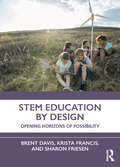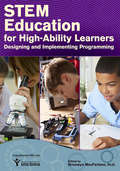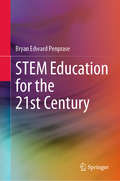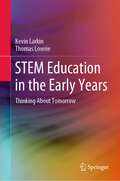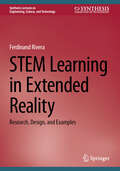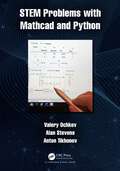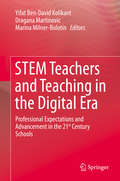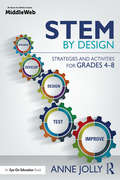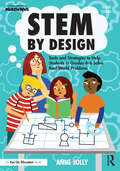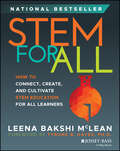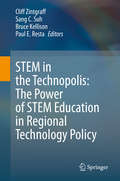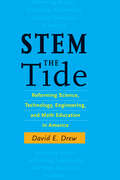- Table View
- List View
STEM Education by Design: Opening Horizons of Possibility
by Sharon Friesen Brent Davis Krista FrancisAn accessible text that assumes no prior knowledge, this book is grounded in the realization that "STEM" and "STEM Education" have not yet evolved into fully coherent fields of study, and fills this gap by offering an original model and strategy for developing coherences in a way that both honors the integrity of each of STEM’s constituent disciplines and explores the ways they can amplify one another when used together to address complex contemporary issues. This book demonstrates how STEM can and should be understood as more than a collection of disciplines; it is a transdisciplinary, possibility-rich domain that is much more than the sum of its parts. Building on the actual work of scientists, engineers, and other professionals, the authors disrupt preconceptions about STEM domains, and provide the tools and evidence-based approaches to create new possibilities for all learners. Covering historical influences, theoretical frameworks, and current debates and challenges, this book positions teachers and students as agents of change. Each chapter features In Brief openers to introduce the topic; Opening Anecdotes to reflect the chapter’s key themes; Sidebars to put core principles in context; Consolidating Key Points activities to summarize and highlight important details; and Challenges to build upon and extend topics explored in the chapter from different angles.
STEM Education for High-Ability Learners
by Bronwyn MacfarlaneSTEM Education for High-Ability Learners: Designing and Implementing Programming focuses on the rigorous articulation of quality STEM education programming to develop STEM talent among high-ability and gifted learners. The intent of this book is to provide a comprehensive resource for educators designing and implementing each of the supports within STEM education by providing a discussion of each critical component for inclusion in a planned, coherent, and high-quality sequenced system. This edited volume provides a cutting-edge discussion of best practices for delivering STEM education by experts in the field. The contributing authors provide a differentiated discussion and recommendations for the learning experiences of gifted students in STEM education programs.
STEM Education for the 21st Century (Springerbriefs In Education Ser.)
by Bryan Edward PenpraseThis book chronicles the revolution in STEM teaching and learning that has arisen from a convergence of educational research, emerging technologies, and innovative ways of structuring both the physical space and classroom activities in STEM higher education. Beginning with a historical overview of US higher education and an overview of diversity in STEM in the US, the book sets a context in which our present-day innovation in science and technology urgently needs to provide more diversity and inclusion within STEM fields. Research-validated pedagogies using active learning and new types of research-based curriculum is transforming how physics, biology and other fields are taught in leading universities, and the book gives profiles of leading innovators in science education and examples of exciting new research-based courses taking root in US institutions. The book includes interviews with leading scientists and educators, case studies of new courses and new institutions, and descriptions of site visits where new trends in 21st STEM education are being developed. The book also takes the reader into innovative learning environments in engineering where students are empowered by emerging technologies to develop new creative capacity in their STEM education, through new centers for design thinking and liberal arts-based engineering. Equally innovative are new conceptual frameworks for course design and learning, and the book explores the concepts of Scientific Teaching, Backward Course Design, Threshold Concepts and Learning Taxonomies in a systematic way with examples from diverse scientific fields. Finally, the book takes the reader inside the leading centers for online education, including Udacity, Coursera and EdX, interviews the leaders and founders of MOOC technology, and gives a sense of how online education is evolving and what this means for STEM education. This book provides a broad and deep exploration into the historical context of science education and into some of the cutting-edge innovations that are reshaping how leading universities teach science and engineering. The emergence of exponentially advancing technologies such as synthetic biology, artificial intelligence and materials sciences has been described as the Fourth Industrial Revolution, and the book explores how these technologies will shape our future will bring a transformation of STEM curriculum that can help students solve many the most urgent problems facing our world and society.
STEM Education in the Early Years: Thinking About Tomorrow
by Kevin Larkin Thomas LowrieThis book analyses and synthesises past and current approaches to STEM Education in the Early Years, particularly the role of digital technologies and play based pedagogies, and provides a look forward to a new way of conceiving STEM Education. It presents a literature review of existing best practice in STEM education, both in Australia and internationally. It also presents theoretical and pedagogical discussions that outlines a new approach to STEM Education, based on a four-year, longitudinal, Early Years project. It provides educational frameworks for educators' use to enhance student learning in STEM, both in formal school contexts and beyond. This book focuses on a number of core themes in the research literature, including STEM education policy (nationally and internationally); the economic, social and political implication of STEM Education; the nexus between digital technologies, STEM, and play based pedagogies; the confidence and competence of early childhood educators and their professional development requirements; STEM education beyond formal schooling; and a new pedagogical approach to STEM education.
STEM Learning
by Mesut Duran Margret Höft Brahim Medjahed Daniel B. Lawson Elsayed A. OradyThis book reports the results of a three-year research program funded by the National Science Foundation which targeted students and teachers from four Detroit high schools in order for them to learn, experience, and use IT within the context of STEM (IT/STEM), and explore 21st century career and educational pathways. The book discusses the accomplishment of these goals through the creation of a Community of Designers-- an environment in which high school students and teachers, undergraduate/graduate student assistants, and STEM area faculty and industry experts worked together as a cohesive team. The program created four project-based design teams, one for each STEM area. Each team had access to two year-round IT/STEM enrichment experiences to create high-quality learning projects, strategies, and curriculum models. These strategies were applied in after school, weekend, and summer settings through hands-on, inquiry-based activities with a strong emphasis on non-traditional approaches to learning and understanding. The book represents the first comprehensive description and analysis of the research program and suggests a plan for future development and refinement.
STEM Learning in Extended Reality: Research, Design, and Examples (Synthesis Lectures on Engineering, Science, and Technology)
by Ferdinand RiveraThis book synthesizes findings from recent and ongoing research on the use of Extended Reality (XR) to support learning of STEM content. XR is slowly being introduced in classrooms due to significant changes in XR technology. These tools were historically costly, unfriendly, and developed only for gamers. Today, XR tools are able to enhance students’ immersive experiences in such settings. In classrooms, in particular, they provide learners with an opportunity to manipulate abstract objects as if they are physical objects. The book begins with an extensive and detailed description and evaluation of the impact of various XR interventions on learning and engagement in STEM classrooms. The author then concludes with theoretical frameworks for investigating learning in computer- immersive contexts and practical implications for effectively using XR tools to learn STEM.
STEM Problems with Mathcad and Python
by Valery Ochkov Alan Stevens Anton TikhonovSTEM Problems with Mathcad and Python seeks to remove the fear of tackling difficult scientific and technical calculations for future mathematicians, engineers, scientists, and other STEM researchers. The authors hope to show that such calculations can be not only useful, but that the process of learning how to do them can be enjoyable, especially with the help of Mathcad and Python programming skills. The book will also illustrate how the use of modern computer software allows one to significantly expand the range of problems considered beyond those conventionally taught. This includes computational experiments, multivariate calculations, inverse problems and optimization problems, with both static and animated visual feedback. Features Suitable for undergraduates and early postgraduates who need simple and accessible guidance for solving practical interdisciplinary technical problems Can be used as an additional textbook in a variety of topics, including Calculus, Linear Algebra, Analytical Geometry, Discrete Mathematics, Computer Science, Computational Mathematics, Scientific Visualization, Computer Graphics Gives computer users access to an exciting new hobby - solving complex problems described in fiction.
STEM Teachers and Teaching in the Digital Era: Professional Expectations and Advancement in the 21st Century Schools
by Dragana Martinovic Yifat Ben-David Kolikant Marina Milner-BolotinThis book brings together researchers from Israel and Canada to discuss the challenges today's teachers and teacher‐educators face in their practice.There is a growing expectation that the 21st century STEM teachers re‐examine their teaching philosophies and adjust their practices to reflect the increasing role of digital technologies. This expectation presents a significant challenge to teachers, who are often asked to implement novel technology‐rich pedagogies they did not have a chance to experience as students or become comfortable with. To exacerbate this challenge, the 21st century teachers function not only in a frequently‐changing educational reality manifested by continuous reforms, but are also bombarded by often contradictory and competing demands from the legislators, administrators, parents, and students. How do we break the vicious circle of reforms and support STEM teachers in making a real change in student learning? This book is unique for at least three reasons. First, it showcases research situated in Israel and Canada that examines the challenges today's teachers and teacher‐educators face in their practice. While the governments of both countries emphasize STEM education, their approaches are different and thus provide for interesting comparisons. Second, in addition to including research-based chapters, prominent scholars discuss the contributions in each of the book sections, problematizing the issues from a global perspective. Third, technology has a potential to empower teachers in this era of change, and this book provides the unique insights from each country, while allowing for comparisons, discussing solutions, and asking new questions.This book will be of interest to all involved in STEM teacher education programs or graduate programs in education, as well as to educational administrators interested in implementing technology in their schools.
STEM by Design: Strategies and Activities for Grades 4-8
by Anne JollyHow do you create effective STEM classrooms that energize students, help them grow into creative thinkers and collaborators, and prepare them for their futures? This practical book from expert Anne Jolly has all the answers and tools you need to get started or enhance your current program. Based on the author’s popular MiddleWeb blog of the same name, STEM by Design reveals the secrets to successful lessons in which students use science, math, and technology to solve real-world engineering design problems. You’ll learn how to: Select and adapt quality existing STEM lessons that present authentic problems, allow for creative approaches, and engage students in meaningful teamwork; Create your own student-centered STEM lessons based on the Engineering Design Process; Assess students’ understanding of basic STEM concepts, their problem-solving abilities, and their level of engagement with the material; Teach STEM in after-school programs to further build on concepts covered in class; Empower girls to aspire to careers in STEM and break down the barriers of gender bias; Tap into STEM's project-based learning style to attract and engage all students. Throughout this user-friendly book, you’ll find design tools such as checklists, activities, and assessments to aid you in developing or adapting STEM lessons. These tools, as well as additional teacher resources, are also available as free downloads from the book’s website, http://www.stem-by-design.com.
STEM by Design: Tools and Strategies to Help Students in Grades 4–8 Solve Real-World Problems
by Anne JollyThe second edition of this practical, how-to guide from expert STEM teacher Anne Jolly reveals the secrets behind designing projects that involve students in using science, math, and technology to engineer solutions for real-world problems. Fully revised and updated from the first edition, each chapter is packed with tools and strategies to help you design and lead exciting STEM projects and lessons and help your students grow into creative thinkers, innovators, and collaborators prepared for life in the 21st century. You’ll learn how to: Select engaging and relevant STEM challenges. Design your own STEM projects using the engineering design process and other acknowledged STEM criteria. Convert existing lessons into quality STEM projects. Include students of different ethnicities and other underrepresented children. Build students’ abilities to work successfully in teams and practice important life skills. Integrate technology into your projects in authentic ways. Assess students’ understanding of STEM concepts and procedures, problem-solving progress, and level of engagement in the project. Involve students in assessing and adjusting their own progress throughout the project. Throughout this user-friendly book you’ll find design tools such as checklists, activities, and assessments to aid you in designing and adapting energizing STEM lessons with your students in Grades 4–8. These tools, as well as other teacher resources, are also available as free downloads from the book website, www.stem-by-design.com.
STEM for All: How to Connect, Create, and Cultivate STEM Education for All Learners
by Leena Bakshi McLeanHelp close the STEM gap through theory and practical tools Containing all of the practical tools needed to put theory into practice, STEM for All by Leena Bakshi McLean provides a roadmap for teachers, instructional coaches, and leaders to better understand the challenges that create low engagement and scores in STEM subjects and implement exciting and culturally relevant teaching plans. This book covers a wealth of key topics surrounding the subject, including classroom culture, discourse, identity, and belonging, family and community participation, and justice-centered core learning. This book uses the Connect, Create, and Cultivate framework from STEM4Real, an organization that provides socially just and culturally relevant STEM teaching and standards-based learning strategies, combined with stories and case studies of real students throughout to provide context for key concepts. In this book, readers will learn about: Six pillars that can throw off the foundation of a classroom, including non-inclusive curriculum and lack of equal access Moments of triumph and resilience that can be used to navigate rocky and recalcitrant relationships Implicit and unconscious biases that can unravel our impact despite our best intentions STEM for All earns a well-deserved spot on the bookshelves of all educators motivated to close the STEM gap and better prepare their students for future college and career opportunities in math and science fields.
STEM in the Technopolis: The Power of STEM Education in Regional Technology Policy
by Sang C. Suh Cliff Zintgraff Bruce Kellison Paul E. RestaThis book addresses how forward-thinking local communities are integrating pre-college STEM education, STEM pedagogy, industry clusters, college programs, and local, state and national policies to improve educational experiences, drive local development, gain competitive advantage for the communities, and lead students to rewarding careers. This book consists of three sections: foundational principles, city/regional case studies from across the globe, and state and national context. The authors explore the hypothesis that when pre-college STEM education is integrated with city and regional development, regions can drive a virtuous cycle of education, economic development, and quality of life.Why should pre-college STEM education be included in regional technology policy? When local leaders talk about regional policy, they usually talk about how government, universities and industry should work together. This relationship is important, but what about the hundreds of millions of pre-college students, taught by tens of millions of teachers, supported by hundreds of thousands of volunteers, who deliver STEM education around the world? Leaders in the communities featured in STEM in the Technopolis have recognized the need to prepare students at an early age, and the power of real-world connections in the process. The authors advocate for this approach to be expanded. They describe how STEM pedagogy, priority industry clusters, cross-sector collaboration, and the local incarnations of global development challenges can be made to work together for the good of all citizens in local communities. This book will be of interest to government policymakers, school administrators, industry executives, and non-profit executives. The book will be useful as a reference to teachers, professors, industry professional volunteers, non-profit staff, and program leaders who are developing, running, or teaching in STEM programs or working to improve quality of life in their communities.
STEM the Tide: Reforming Science, Technology, Engineering, and Math Education in America
by David E. DrewProven strategies for reforming STEM education in America’s schools, colleges, and universities.One study after another shows American students ranking behind their international counterparts in the STEM fields—science, technology, engineering, and math. Businesspeople and cultural critics such as Bill Gates warn that this alarming situation puts the United States at a serious disadvantage in the high-tech global marketplace of the twenty-first century, and President Obama places improvement in these areas at the center of his educational reform. What can be done to reverse this poor performance and to unleash America’s wasted talent?David E. Drew has good news—and the tools America needs to keep competitive. Drawing on both academic literature and his own rich experience, Drew identifies proven strategies for reforming America’s schools, colleges, and universities, and his comprehensive review of STEM education in the United States offers a positive blueprint for the future. These research-based strategies include creative and successful methods for building strong programs in science and mathematics education and show how the achievement gap between majority and minority students can be closed. A crucial measure, he argues, is recruiting, educating, supporting, and respecting America’s teachers. Accessible, engaging, and hard hitting, STEM the Tide is a clarion call to policymakers, administrators, educators, and everyone else concerned about students’ participation in the STEM fields and America’s competitive global position.
STEMscopes™ Alabama Math, Assessment Workbook, Fourth Grade
by Accelerate LearningNIMAC-sourced textbook
STEMscopes™ Alabama Math, Assessment Workbook, Second Grade
by Accelerate LearningNIMAC-sourced textbook
STEMscopes™ Alabama Math, Assessment Workbook, Third Grade
by Accelerate LearningNIMAC-sourced textbook
STEMscopes™ Alabama Math, Student Notebook, Fifth Grade, Volume 1
by Accelerate LearningNIMAC-sourced textbook
STEMscopes™ Alabama Math, Student Notebook, First Grade
by Accelerate LearningNIMAC-sourced textbook
STEMscopes™ Alabama Math, Student Notebook, Fourth Grade, Volume 1
by Accelerate LearningNIMAC-sourced textbook
STEMscopes™ Alabama Math, Student Notebook, Fourth Grade, Volume 2
by Accelerate LearningNIMAC-sourced textbook
STEMscopes™ Alabama Math, Student Notebook, Kindergarten
by Accelerate LearningNIMAC-sourced textbook
STEMscopes™ Alabama Math, Student Notebook, Second Grade
by Inc. Accelerate LearningNIMAC-sourced textbook
STEMscopes™ Alabama Math, Student Notebook, Third Grade, Volume 1
by Accelerate LearningNIMAC-sourced textbook
STEMscopes™ Alabama Math, Student Notebook, Third Grade, Volume 2
by Inc. Accelerate LearningNIMAC-sourced textbook
STEMscopes™ Alabama Math: Assessment Workbook, Fifth Grade
by Accelerate LearningNIMAC-sourced textbook
